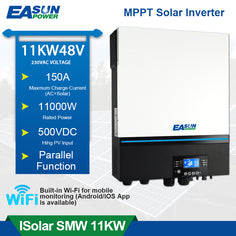Unveiling the Secrets: The Ultimate Guide to Choosing the Perfect Solar Inverter for Your Home!
As the world shifts towards renewable energy, solar power has emerged as a leading solution for residential energy needs. At the heart of every solar energy system lies the solar inverter for home, a critical component that ensures the efficient conversion of sunlight into usable electricity. This article aims to demystify the world of solar inverters, offering insights into their types, functions, and the essential features to consider when selecting the right inverter for your home. Whether you're a homeowner looking to reduce energy bills or an eco-conscious individual aiming to lessen your carbon footprint, understanding solar inverters will empower you to make informed decisions on your solar energy journey.

Understanding Solar Inverters
A solar inverter is an electronic device that converts the direct current (DC) generated by solar panels into alternating current (AC), which is the form of electricity used in homes. Without an inverter, the energy produced by solar panels would be unusable for most household appliances. The inverter plays a crucial role in a solar energy system by not only facilitating this conversion but also optimizing the energy output. The efficiency of an inverter can significantly impact the overall performance of a solar system. It is essential for homeowners to understand how inverters function to ensure that they can harness solar energy effectively, maximizing both savings and environmental benefits.
Types of Solar Inverters
When it comes to solar inverters, there are three primary types suited for residential use: string inverters, microinverters, and power optimizers. String inverters are the most common type, connecting multiple solar panels in series. They are generally cost-effective and easy to install, but their performance can be affected by shading or panel malfunction. Microinverters, on the other hand, are installed on each individual panel, allowing for optimized energy production regardless of shading or panel performance issues. This type is particularly beneficial for homes with complex roof layouts. Power optimizers combine features of both string inverters and microinverters, working to maximize the output of each panel while still using a central inverter. Each type has its own advantages and disadvantages, making it vital for homeowners to assess their specific needs and circumstances before choosing the right inverter type.
Key Features to Consider
Selecting the perfect solar inverter goes beyond just picking a type. Homeowners should consider essential features such as efficiency ratings, which indicate how well the inverter converts DC to AC power; warranty periods, which reflect the manufacturer's confidence in the product; monitoring capabilities for tracking energy production; and safety features that protect against potential electrical hazards. Additionally, the compatibility of the inverter with the existing solar panel system should be assessed. By focusing on these key features, homeowners can ensure they choose an inverter that not only fits their budget but also meets their energy needs effectively.
Benefits of Installing a Solar Inverter
Investing in a high-quality solar inverter comes with a multitude of benefits. Firstly, it can lead to significant energy savings, as homeowners can generate their own electricity and reduce reliance on the grid. This not only lowers energy bills but can also provide protection against fluctuating energy prices. Furthermore, utilizing solar energy contributes positively to the environment by reducing greenhouse gas emissions and fossil fuel dependency. Additionally, the installation of a solar energy system, including a reliable inverter, can increase property value. Many homebuyers are attracted to energy-efficient homes, making solar installations a wise investment for the future.
Installation and Maintenance Tips
When installing a solar inverter, it is crucial to ensure proper maintenance to prolong its lifespan. Homeowners should consult certified professionals for regular inspections and compliance with local regulations. Keeping the inverter clean and free from debris is essential for optimal performance. Monitoring energy output and efficiency should be done periodically to identify any signs of damage or wear. Following these tips will help ensure that the solar energy system operates efficiently for years to come.
Making Informed Choices for Your Solar Inverter
In summary, choosing the right solar inverter is a pivotal step in maximizing the efficiency and benefits of a home solar energy system. With a clear understanding of the different types of inverters, key features to consider, and the numerous advantages they offer, homeowners can make informed decisions that align with their energy needs and environmental goals. As the demand for renewable energy continues to grow, investing in a quality solar inverter will not only enhance energy savings but also contribute to a sustainable future. Take the first step towards a greener lifestyle and explore your options for solar inverter installation today!



